初中英语数词用法及练习
必备英语数词技巧全解及练习题(含答案)
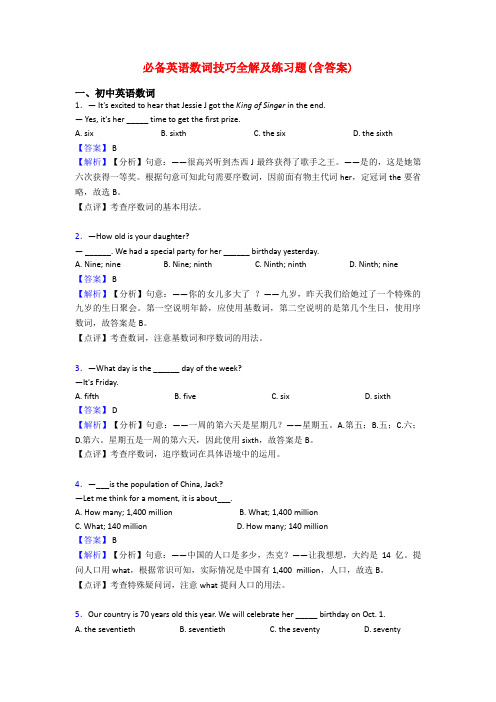
必备英语数词技巧全解及练习题(含答案)一、初中英语数词1.— It's excited to hear that Jessie J got the King of Singer in the end.— Yes, it's her _____ time to get the first prize.A. sixB. sixthC. the sixD. the sixth【答案】 B【解析】【分析】句意:——很高兴听到杰西J最终获得了歌手之王。
——是的,这是她第六次获得一等奖。
根据句意可知此句需要序数词,因前面有物主代词her,定冠词the要省略,故选B。
【点评】考查序数词的基本用法。
2.—How old is your daughter?— ______. We had a special party for her ______ birthday yesterday.A. Nine; nineB. Nine; ninthC. Ninth; ninthD. Ninth; nine【答案】 B【解析】【分析】句意:——你的女儿多大了?——九岁,昨天我们给她过了一个特殊的九岁的生日聚会。
第一空说明年龄,应使用基数词,第二空说明的是第几个生日,使用序数词,故答案是B。
【点评】考查数词,注意基数词和序数词的用法。
3.—What day is the ______ day of the week?—It's Friday.A. fifthB. fiveC. sixD. sixth【答案】 D【解析】【分析】句意:——一周的第六天是星期几?——星期五。
A.第五;B.五;C.六;D.第六。
星期五是一周的第六天,因此使用sixth,故答案是B。
【点评】考查序数词,追序数词在具体语境中的运用。
4.—___is the population of China, Jack?—Let me think for a moment, it is about___.A. How many; 1,400 millionB. What; 1,400 millionC. What; 140 millionD. How many; 140 million【答案】 B【解析】【分析】句意:——中国的人口是多少,杰克?——让我想想,大约是14亿。
初中英语数词专项训练100(附答案)
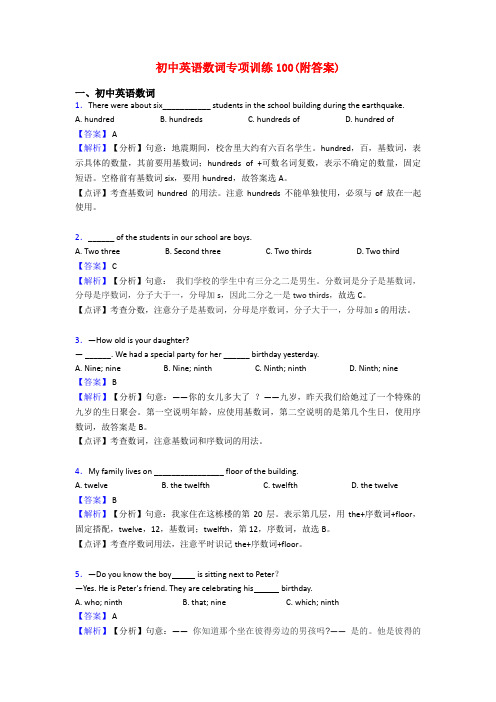
初中英语数词专项训练100(附答案)一、初中英语数词1.There were about six___________ students in the school building during the earthquake.A. hundredB. hundredsC. hundreds ofD. hundred of【答案】 A【解析】【分析】句意:地震期间,校舍里大约有六百名学生。
hundred,百,基数词,表示具体的数量,其前要用基数词;hundreds of +可数名词复数,表示不确定的数量,固定短语。
空格前有基数词six,要用hundred,故答案选A。
【点评】考查基数词hundred的用法。
注意hundreds不能单独使用,必须与of放在一起使用。
2.______ of the students in our school are boys.A. Two threeB. Second threeC. Two thirdsD. Two third【答案】 C【解析】【分析】句意:我们学校的学生中有三分之二是男生。
分数词是分子是基数词,分母是序数词,分子大于一,分母加s,因此二分之一是two thirds,故选C。
【点评】考查分数,注意分子是基数词,分母是序数词,分子大于一,分母加s的用法。
3.—How old is your daughter?— ______. We had a special party for her ______ birthday yesterday.A. Nine; nineB. Nine; ninthC. Ninth; ninthD. Ninth; nine【答案】 B【解析】【分析】句意:——你的女儿多大了?——九岁,昨天我们给她过了一个特殊的九岁的生日聚会。
第一空说明年龄,应使用基数词,第二空说明的是第几个生日,使用序数词,故答案是B。
【点评】考查数词,注意基数词和序数词的用法。
【英语】初中英语数词解题技巧及经典题型及练习题(含答案)及解析

【英语】初中英语数词解题技巧及经典题型及练习题(含答案)及解析一、初中英语数词1.— I think A Bite of China Ⅲis not so good as __________.— Oh, I agree with you..A. two first.B. the two firstC. first twoD. the first two【答案】 D【解析】【分析】句意:——我认为《舌尖上的中国3》不如前两个好。
——噢,我同意你的观点。
first,最初的,形容词,the first+基数词,表示前几个,故选D。
【点评】此题考查数词。
the first修饰基数词,表示前几个。
2.—How old is your daughter?— ______. We had a special party for her ______ birthday yesterday.A. Nine; nineB. Nine; ninthC. Ninth; ninthD. Ninth; nine【答案】 B【解析】【分析】句意:——你的女儿多大了?——九岁,昨天我们给她过了一个特殊的九岁的生日聚会。
第一空说明年龄,应使用基数词,第二空说明的是第几个生日,使用序数词,故答案是B。
【点评】考查数词,注意基数词和序数词的用法。
3.There are 24 solar terms in a year. Grain Rain often starts in April, the ________ month of the year.A. ThirdB. fourthC. fifth【答案】 B【解析】【分析】句意:一年有24个节气。
谷物雨通常在一年中的四月开始。
A:Third 第三;B:fourth第四;C:fifth第五。
空格前有定冠词the与可数名词单数month,要用序数词。
根据 Grain Rain often starts in April ,可知四月份是一年中的第四个月,要用序数词fourth,故选B。
【英语】 中考英语数词专项训练100(附答案)含解析
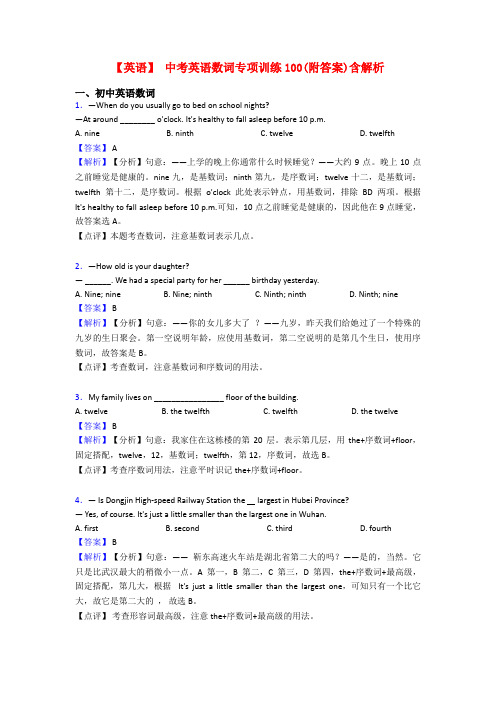
【英语】中考英语数词专项训练100(附答案)含解析一、初中英语数词1.—When do you usually go to bed on school nights?—At around ________ o'clock. It's healthy to fall asleep before 10 p.m.A. nineB. ninthC. twelveD. twelfth【答案】 A【解析】【分析】句意:——上学的晚上你通常什么时候睡觉?——大约9点。
晚上10点之前睡觉是健康的。
nine九,是基数词;ninth第九,是序数词;twelve十二,是基数词;twelfth第十二,是序数词。
根据o'clock此处表示钟点,用基数词,排除BD两项。
根据It's healthy to fall asleep before 10 p.m.可知,10点之前睡觉是健康的,因此他在9点睡觉,故答案选A。
【点评】本题考查数词,注意基数词表示几点。
2.—How old is your daughter?— ______. We had a special party for her ______ birthday yesterday.A. Nine; nineB. Nine; ninthC. Ninth; ninthD. Ninth; nine【答案】 B【解析】【分析】句意:——你的女儿多大了?——九岁,昨天我们给她过了一个特殊的九岁的生日聚会。
第一空说明年龄,应使用基数词,第二空说明的是第几个生日,使用序数词,故答案是B。
【点评】考查数词,注意基数词和序数词的用法。
3.My family lives on ________________ floor of the building.A. twelveB. the twelfthC. twelfthD. the twelve【答案】 B【解析】【分析】句意:我家住在这栋楼的第20层。
(英语)英语数词练习题及答案及解析

(英语)英语数词练习题及答案及解析一、初中英语数词1.Ten years ago the population of our village was that of theirs.A. as twice large asB. twice as large asC. twice as much asD. as twice much as 【答案】 B【解析】【分析】句意:十年前,我们村子的人口是他们的两倍。
根据句意可知,这里考查的是表示倍数的句型,twice在这里的意思是两倍,twice as…as,表示是……的两倍,并且修饰人口众多时用形容词large或big,因此是twice as large as,故选B。
【点评】考查倍数的表达方式。
2.—Do you know the boy is sitting next to Peter?—Yes. He is Peter's friend. They are celebrating his birthday.A. who; ninthB. that; nineC. which; ninth【答案】 A【解析】【分析】句意:——你知道那个坐在彼得旁边的男孩吗?——是的。
他是彼得的朋友。
他们正在庆祝他的九岁生日。
分析句子结构可知,第一空所在句子是定语从句,先行词是人,连接词在从句中作主语,所以应该用who/that引导,which连接定语从句时先行词应该是物,故排除C;nine九,基数词;ninth第九,序数词;第二空根据空后的birthday为名词单数可知,此处需要序数词,表示某人几岁生日应该用序数词表示第几个生日,故选A。
【点评】考查定语从句的连接词的辨析和序数词。
注意区别定语从句的连接词的使用原则,理解单词词义。
3.There are ______________ months in a year. December is the ______________ month of a year.A. twelve; twelveB. twelfth; twelfthC. twelve; twelfthD. twelfth; twelve 【答案】 C【解析】【分析】句意:一年有十二个月,十二月是一年中的第十二个月。
初中英语 中考复习--数词的总结归纳与练习
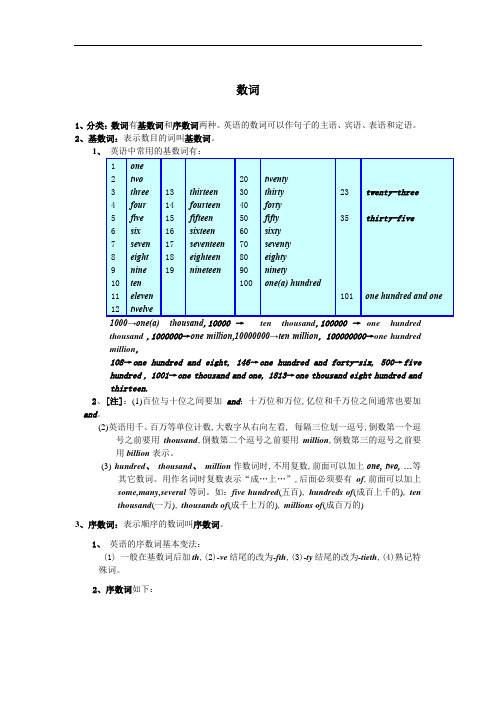
数词1、分类:数词有基数词和序数词两种。
英语的数词可以作句子的主语、宾语、表语和定语。
2、基数词:表示数目的词叫基数词。
1、英语中常用的基数词有:1 2 3 4 5 6 7 8 9 10 11 12onetwothreefourfivesixseveneightnineteneleventwelve13141516171819thirteenfourteenfifteensixteenseventeeneighteennineteen2030405060708090100twentythirtyfortyfiftysixtyseventyeightyninetyone(a) hundred2335101twenty-threethirty-fiveone hundred and one1000→one(a) thousand,10000→ten thousand,100000→one hundredthousand ,1000000→one million,10000000→ten million,100000000→one hundredmillion,108→one hundred and eight, 146→one hundred and forty-six, 500→five hundred , 1001→one thousand and one, 1813→one thousand eight hundred and thirteen.2、[注]:(1)百位与十位之间要加and;十万位和万位,亿位和千万位之间通常也要加and。
(2)英语用千、百万等单位计数,大数字从右向左看,每隔三位划一逗号,倒数第一个逗号之前要用thousand,倒数第二个逗号之前要用million,倒数第三的逗号之前要用billion表示。
(3) hundred、thousand、million作数词时,不用复数,前面可以加上one, two, …等其它数词。
(英语)英语数词练习题20篇及解析

(英语)英语数词练习题20篇及解析一、初中英语数词1.Li Hua is going to be an elder brother. His parents are planning to have their ________child.A. firstB. secondC. oneD. two【答案】 B【解析】【分析】句意:李华要当哥哥了,他的父母计划生二胎。
A第一,B第二,C一,D二,限定词+序数词+名词,第几个......,选项C和D是基数词,故排除,根据Li Hua is going to be an elder brother,可知是二胎,及第二个孩子,故选B。
【点评】考查数词,注意根据 Li Hua is going to be an elder brother的语境选择序数词的用法。
2.The number of the students in our school is about four __________._______ of them are girls.A. thousand; Two thirdsB. thousands; Two thirdC. thousands; Two thirdsD. thousand; Two third【答案】 A【解析】【分析】句意:我们学校的学生人数大约是四人。
三分之二是女孩。
four基数词后用thousand的原形,分数表达形式是分子是基数词,分母是序数词,分子大于一,分母用复数形式,故三分之二是two thirds,故选A。
【点评】考查数词,注意分数的用法。
3.— Is Dongjin High-speed Railway Station the largest in Hubei Province?— Yes, of course. It's just a little smaller than the largest one in Wuhan.A. firstB. secondC. thirdD. fourth【答案】 B【解析】【分析】句意:——靳东高速火车站是湖北省第二大的吗?——是的,当然。
初中英语语法讲解与练习【数-词】
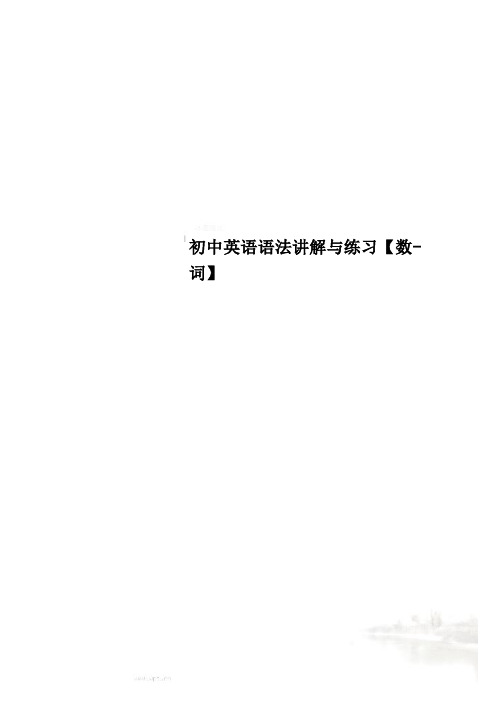
初中英语语法讲解与练习【数-词】数词数词英语数词表示数目或者顺序,可分为基数词和序数词。
基数词表示数量,序数词表示顺序。
知识梳理:提纲挈领,抓住重点和难点!一、基数词的构成1.1-12的基数词是独立的单词,即:one,two,three,four,five,six,seven,eight,nine,ten,eleven,twelve。
2.13-19的基数词以-teen结尾。
如:fourteen,seventeen等,但13,15,18较特殊,13-thirteen 15-fifteen 18-eighteen。
3.20-90的整十位均以-ty结尾。
如:sixty,ninety,但20,30,40,50,80较特殊,20-twenty 30-thirty 40-forty 50-fifty 80-eighty。
4.十位数与个位数之间要加连字符号"-",如:28-twenty-eight,96-ninety-six。
为序数词时,有特别之处。
1.one--- first, two --- second, three --- third, five --- fifth, nice --- ninth, twelve --- twelfth2. 以ty 结尾的单词,要先变y为I, 在加-eth. 例如:thirty ---thirtieth, fifty ---fiftieth3. 以one, two, three 等结尾的多位数词,要将各位数变成序数词。
例如:twenty-one --- twenty-first, one hundred and one --- one hundred and first注意:序数词前常用定冠词,有时还可以用不定冠词a/an 则表示"又一"的意思。
例如:Mr Brown has a second car. 布朗先生另外还有一辆车。
- 1、下载文档前请自行甄别文档内容的完整性,平台不提供额外的编辑、内容补充、找答案等附加服务。
- 2、"仅部分预览"的文档,不可在线预览部分如存在完整性等问题,可反馈申请退款(可完整预览的文档不适用该条件!)。
- 3、如文档侵犯您的权益,请联系客服反馈,我们会尽快为您处理(人工客服工作时间:9:00-18:30)。
初中英语数次归纳及练习数词主要分为基数词和序数词两类。
一、数词的分类1. 基数词表示数目的词称为基数词。
其形式如下:A.从1——10one,two,three,four,five,six,seven,eight,nine,ten.B.从 11——19eleven,twelve, thirteen, fourteen, fifteen, sixteen, seventeen,eighteen, nineteen.这里除 eleven, twelve, thirteen, fifteen, eighteen为特殊形式外,fourteen,sixteen,seventeen,nineteen都是由其个位数形式后添加后缀-teen 构成。
C.从 21——99整数几十中除twenty,thirty, forty,fifty,eighty为特殊形式外,sixty,seventy,ninety都是其个位数形式后添加后缀-ty构成。
表示几十几时,在几十和个位基数词形式之间添加连字符“-”21 twenty-one76 seventy-sixD.百位数个数基数词形式加“hundred”,表示几百,在几十几与百位间加上and.101 a hundred and one320 three hundred and twenty648 six hundred and forty-eightE.千位数以上从数字的右端向左端数起,每三位数加一个逗号“,”。
从右开始,第一个“,”前的数字后添加 thousand,第二个“,”前面的数字后添加 million,第三个“,”前的数字后添加 billion。
然后一节一节分别表示,两个逗号之间最大的数为百位数形式。
2,648 two thousand six hundred and forty-eight16,250,064 sixteen million two hundred and fifty thousand sixty-four 5,237,166,234 five billion,two hundred and thirty-seven million,one hundred and sixty-six thousand,two hundred and thirty-fourF.基数词在表示确切的数字时,不能使用百、千、百万、十亿的复数形式;但是,当基数词表示不确切数字,如成百、成千上万,三三两两时,基数词则以复数形式出现。
There are hundreds of people in the hall.大厅里有数以百计的人。
Thousands and thousands of people come to visit the Museum of Qin Terra-Cotta Warriors and Horses every day.每天有成千上万的人来参观兵马涌博物馆。
They went to the theatre in twos and threes.他们三三两两地来到了剧院。
G.表示人的不确切岁数或年代,用几十的复数形式表示。
He became a professor in his thirties.他三十多岁时成为了教授。
She died of lung cancer in her forties.她四十来岁时死于肺癌。
It was in the 1960s.那是在二十世纪六十年代。
H.基数词的句法功能基数词在句中可作主语、宾语、定语、表语、同位语。
The two happily opened the box.两个人高兴地打开了盒子。
(作主语)I need three altogether.我总共需要三个。
(作宾语)Four students are playing volleyball outside.四个学生在外面打排球。
(作定语)We are sixteen.我们是16个人。
(作表语)They three tried to finish the task before sunset.他们三个人尽力想在日落前完成任务。
(作同位语)2. 序数词表示顺序的词称为序数词。
序数词的主要形式:A.从第一至第十九其中,one—first,two—second,three— third, five—fifth,eight—eighth,nine—ninth,twelve— twelfth为特殊形式,其它的序数词都是由其相对应的基数词后面添加“th”构成。
例如: six—sixth、nineteen—nineteenth.B.从第二十至第九十九整数第几十的形式由其对应的基数词改变结尾字母y为i,再加“eth”构成。
twenty——twentieth thirty——thirtieth表示第几十几时,用几十的基数词形式加上连字符“-”和个位序数词形式一起表示。
thirty-first 第三十一fifty-sixth 第五十六seventy-third 第七十三ninety-ninth 第九十九C.第一百以上的多位序数词由基数词的形式变结尾部分为序数词形式来表示。
one hundred and twenty-first 第一百二十一one thousand,three hundred and twentieth 第一千三百二十D.序数词的缩写形式有时,序数词可以用缩写形式来表示。
主要缩写形式有。
first——lst second——2nd third——3rdfourth——4th sixth——6th twentieth——20thtwenty-third——23rd其中lst,2nd,3rd为特殊形式,其它的都是阿拉伯数字后加上th。
E.序数词的句法功能序数词在句中可作主语、宾语、定语和表语。
The second is what I really need.第二个是我真正需要的。
(作主语)He choose the second.他挑选了第二个。
(作宾语)We are to carry out the first plan.我们将执行第一个计划。
(作定语)She is the second in our class.在我们班她是第二名。
(作表语)注:序数词在使用时,通常前面要加定冠词 the;但是如果序数词前出现不定冠词a或an时,则表示“再——”,“又——”。
We’ll go over it a second time.我们得再念第二遍。
We’ve tried it three times.Must we try it a fourth time?我们已经试过三遍了,还必须试一次(第四次)吗?另外,基数词也可以表示顺序。
只需将基数词放在它所修饰的名词之后即可,不需要添加定冠词。
the first lesson——Lesson Onethe fifth page——Page 5(five)the twenty-first room——Room 21(twenty-one)二、时刻表示法1. 表示几点钟用基数词加可以省略的o`clock5:00 读作 five o`clock 或 five2. 表示几点过几分,在分钟后加past,再加小时five past seven 七点过五分half past six 六点半a quarter past eight 八点过一刻seven past eight 八点过七分3. 表示几点差几分,在分钟后面加to,再加小时ten to eight 差十分八点(七点五十分)a quarter to twelve 差一刻十二点(十一点四十五分)twenty to six 差二十分六点(五点四十分)在日常生活中,常用下列简单方法表示时间。
以小时、分种为单位分别读出数字。
6:31 读作 six thirty-one10:26读作 ten twenty-six14:03 读作 fourteen o three16:15 读作 sixteen fifteen18:30 读作 eighteen thirty23:55 读作 twenty-three fifty-five注:时刻表上的时间大多采用24小时表示法,这样就不需要用a.m.表示上午,p.m.表示下午了。
三、年月表示法1.世纪可以用定冠词加序数词加世纪century表示,也可以用定冠词加百位进数加`s表示the sixth(6th)century 公元六世纪the eighteenth(18th)century 公元十八世纪the 1900`s 二十世纪the 1600`s 十七世纪这里,用百位数整数表示的世纪比这一百位阿拉伯数字本身多一个世纪。
2. 年代用定冠词及基数词表示的世纪加十位整数的复数形式构成in the 1930`s(in the thirties of the twentieth century或 in the nineteen thirties)在二十世纪三十年代in the 1860`s(in the sixties of the 19th century或 in the eighteen sixties)在十九世纪六十年代In the 1870`s when Marx was already in his fifties,he found it important to study the situation in Russia,so he began to learn Russian.在十九世纪七十年代当马克思已经五十多岁时,他发现研究俄国的形势很重要,便开始学习俄语。
3. 表示某年代的早期、中期和晚期,可以在定冠词后,年代前添加 early,mid-,latein the early 1920`s 在二十世纪二十年代早期in the mid-1950`s 在二十世纪五十年代中期4. 年月日表示法A.年份用基数词表示,一般写为阿拉伯数字,读时可以以hundred为单位,也可以以世纪、年代为单位分别来读。
1949 读作 nineteen hundred and forty-nine 或 nineteen forty-nine1800 读作 eighteen hundred253 读作 two hundred and fifty-three或two fifty-three1902 读作 nineteen hundred and two或 nineteen o two表示在哪一年,一般在年数前加介词in,使用year时,year放在数词之前。
in the year two fifty-three B.C. 在公元前253年但是,通常采用in加表示年份的阿拉伯数字。
